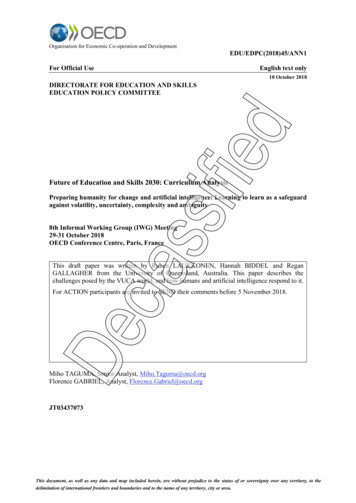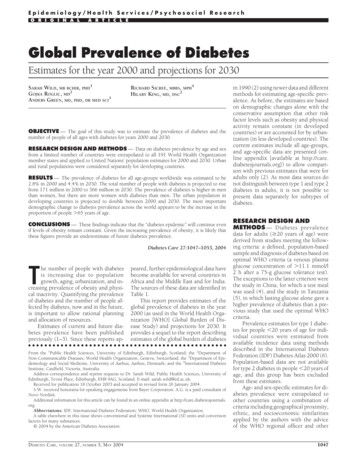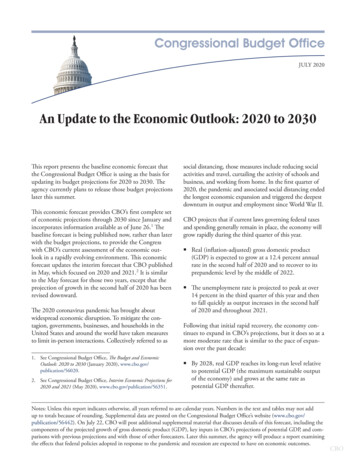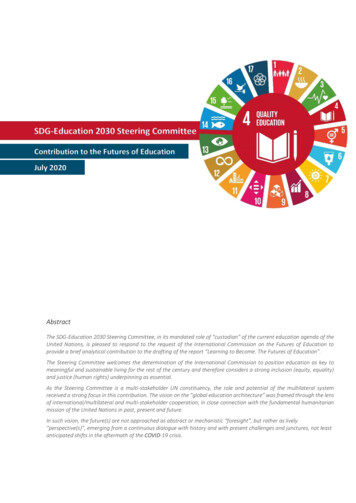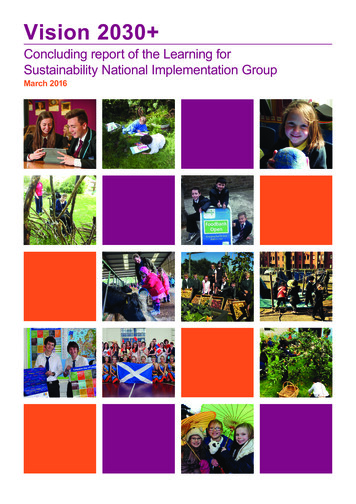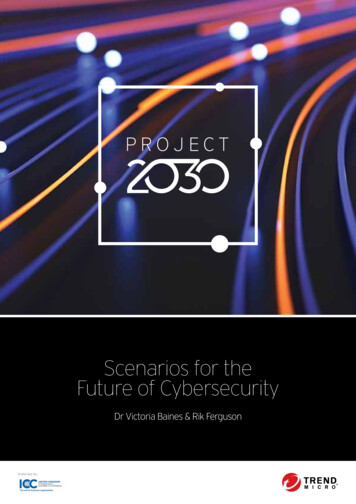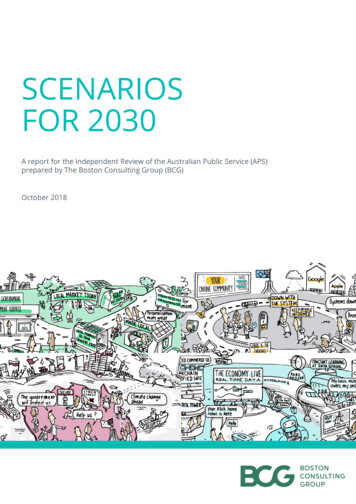
Transcription
SCENARIOSFOR 2030A report for the Independent Review of the Australian Public Service (APS)prepared by The Boston Consulting Group (BCG)October 2018
DisclaimerThis report has been prepared for the APS Review Panel by the Boston Consulting Group (BCG). The APS Review Panel and Department ofPrime Minister & Cabinet (PM&C) have been consulted in the preparation of this report, however, the views expressed in this report do notnecessarily refl ct the views of the APS Review Panel or PM&C.The services and materials provided by The Boston Consulting Group (BCG) are subject to BCG’s Standard Terms or such other agreementas may have been executed by BCG and the Commonwealth Government (the Client). BCG does not provide legal, accounting, or tax advice.The Commonwealth is responsible for obtaining independent advice concerning these matters. This advice may affect the guidance givenby BCG. Further, BCG has made no undertaking to update these materials after the date hereof, notwithstanding that such information maybecome outdated or inaccurate.The materials contained in this report are designed for the sole use of the Client and solely for the limited purposes described in the report.The materials shall not be copied or given to any person or entity other than the Client (Third Party) without the prior written consent of BCG.These materials serve only as the focus for discussion; they are incomplete without the accompanying oral commentary and may not berelied on as a stand-alone document. Further, Third Parties may not, and it is unreasonable for any Third Party to, rely on these materials forany purpose whatsoever. To the fullest extent permitted by law (and except to the extent otherwise agreed in a signed writing by BCG), BCGshall have no liability whatsoever to any Third Party, and any Third Party hereby waives any rights and claims it may have at any time againstBCG with regard to the services, this presentation, or other materials, including the accuracy or completeness thereof. Receipt and review ofthis document shall be deemed agreement with and consideration for the foregoing.BCG does not provide fairness opinions or valuations of market transactions, and these materials should not be relied on or construed assuch. Further, the financial valuations, projected market and financial in ormation, and conclusions contained in these materials are basedupon standard valuation methodologies, are not definiti e forecasts, and are not guaranteed by BCG. BCG has used public and/or confidential data and assumptions provided to BCG by the Client. BCG has not independently verifi d the data and assumptions used in theseanalyses. Changes in the underlying data or operating assumptions will clearly impact the analyses and conclusions.Scenarios for the Australian Public Service in 2030October 2018
ContentsContents3Summary412Introduction and ContextApproach673Megatrends113.1 Theme 1: Changing expectations113.2 Theme 2: Advances in technology123.3 Theme 3: Societal and geo-political shifts133.4 Theme 4: Changing work14415Scenarios4.1 Scenario: #TECHSPLOSION164.2 Scenario: DEVOLUTION REVOLUTION194.3 Scenario: WIKIGOV224.4 Scenario: NEW WORLD (DIS)ORDER25528Common success factors5.1 Alignment of limited resources to achieve greatest impact and optimise outcomes295.2 Highly tailored policies and service delivery to individuals and local areas315.3 Extensively using data and analytics for policy and delivery, whilst protecting againstthe threat of cyber attacks345.4 Capacity to deploy a broad range of specialist talent365.5 Ability to work fl xibly across organisational boundaries in multi-disciplinary approaches385.6 Operate transparently, ethically and in the public interest, involving citizens in policy andservice design and development40643ConclusionFuture Scenarios for the APS in 20303
SummaryThe Australian Government commissioned an Independent Reviewof the Australian Public Service (APS) to ensure it is fit-for-purpose toserve Australian governments and the Australian people, now and intothe future. The APS Review Secretariat engaged The Boston ConsultingGroup (BCG) to undertake a scenario planning exercise to inform itsrecommendations. Together we developed four scenarios for the APSin 2030, and identified the key success factors for each scenario. Weundertook a high-level gap analysis against the common implicationsand made recommendations to best prepare the APS for the future.This document summarises the outcomes of that work.The four scenarios depict potential futures for the APS focusing on high-impact megatrends where thereis also a high degree of uncertainty regarding the direction or scale of how those trends could evolve.The four scenarios are:The uptake and evolution of disruptive andbreakthrough technologies, such as artificialintelligence (AI), quantum computing, bio-technologyand blockchain accelerates. Data, advanced analyticsand AI become central to government policy andoperations.Local institutions and organisations increase inrelevance as Australian people increasingly placemore trust and confidence in them. People becomemore disconnected and skeptical of big institutions.As a result government has devolved more policyand service design to state and local governmentsto promote place-based approaches.The Australian public’s trust in institutions hasrapidly declined. Trust in the APS has also fallen,and it is struggling to make progress on issues.The Australian public demand more levels oftransparency and direct influence on governmentdecision making often engaging through digitalplatforms that support genuine civic engagementand participatory democracy.Political, economic, environmental andsocial instability accelerates. Trade wars andprotectionism prevails, tensions remain highand multinational agreements and internationalorganisations break down. Nations are turninginwards, and people expect and trust theirgovernment to advocate for their interestsand keep them safe and secure.4Future Scenarios for the APS in 2030
From each scenario, we have identified six common success factors for the APS and developedrecommendations to improve the readiness of the APS for the future. These common success factorswill allow the APS to take advantage of the opportunities and prepare for the risks of a range of scenarios.Common success factors1Alignment of limited resources to achievegreatest impact and optimise outcomesRecommendations Develop outcome based managementand funding models Increase APS non-Canberra presence andcross-sectoral working2Highly tailored policies and servicedelivery to individuals and local areas3Extensively using data and analyticsfor policy and delivery, whilst protectingagainst the threat of cyber attacks4Capacity to deploy a broad rangeof specialist talent5Ability to work flexibly acrossorganisational boundaries inmultidisciplinary approaches Foster an adaptive and agile APSworkforce and innovation culture6Operate transparently, ethically and inthe public interest, involving citizensin policy and service design anddevelopment Develop open government platforms,co-design and citizen engagementmechanisms Adopt open, platform-based institutionalarchitectures Invest in the development of digital skillsand talent at scale, particularly in dataanalytics and emerging technologies Develop Professional competencies Establish APS talent hubs to attract andretain talentThe aim of this exercise is to help the Review Panel build a robust understanding of the potentialoperating environments the APS may face in the future and enable the Panel to test the robustnessof future recommendations against the scenarios.Future Scenarios for the APS in 20305
Introduction and Context About the IndependentReview into the Australian Public ServiceThe Australian Government has commissioned an Independent Review into theAPS. The Review is led by an independent panel of six individuals with public andprivate sector experience, and chaired by Mr David Thodey AO. The Review’s terms ofreference are to define an ambitious program of transformational reforms to ensurethe APS is fit-for-purpose for the coming decades and to guide and accelerate futurereform activities.About this report and the purpose of scenariosAs part of its work to explore the long-term future of the APS, the APS ReviewSecretariat commissioned BCG to undertake a scenario planning exercise.The purpose of this work was to identify potential future scenarios; outline thechallenges the APS may face in these environments; identify relative gaps in currentAPS capabilities; and set out clear recommendations to address these gaps.Scenario planning is a powerful methodology that helps deal with uncertainty andovercome our tendency to rely on extrapolation of current trends and short-termthinking. It works by defining a range of plausible future environments, focusing ona small number of trends where there is significant ambiguity. In reality, there arean infinite number of potential scenarios and the future is likely to contain elementsof all four scenarios. The point is to focus on actions that ensure organisationalpreparedness, resilience and fitness-for-purpose regardless of how the futureeventuates.6Future Scenarios for the APS in 2030
Approach Scenario developmentA five-phase process was used to develop scenarios andpotential recommendations for the APS (Figure 1).Figure 1: Scenario development processPhase 1Phase 2Phase 3Phase 4Phase 5IdentifymegatrendsAnalyseuncertaintiesDevelop futurescenariosIdentify commonsuccess factorsGap analysis andrecommendationsWhich trendshave the highestimpact?Which trends havethe greatest level ofuncertainty?How could theuncertainties playout to 2030?What does successlook like in eachscenarioHow should the APSprepare for eachscenario?BCG’s Centre for Sensingand Mining the Futureto identify more thana 100 key market,demographic, consumerand competitive trendsWorkshop #1 with ReviewPanel, Secretariat andglobal experts to refinethe impact on the APSand uncertainty of thekey trendsTake a combination ofpoints on the axes ofuncertainty to developdivergent but crediblefuture scenariosUndertake high level gapanalysis to understandthe level of changerequired to get fromcurrent state to meetcommon success factorWide range of inputs,including research andexpert interviews to refinethe long list of trendsOf the high impacttrends, identify thosewith greatest uncertaintyin direction, pace,magnitudeUnderstand theimplications of eachscenario by holdingworkshops withgovernment executivesand BCG experts tounderstand implicationsof each scenarioSurvey of APS leadershipto identify the impacton the APS and thepreparedness of the APSfor the trendsDevelop axes ofuncertainty based on highimpact, uncertain trendsWorkshop #2 with APSand experts to play outthe scenarios and identifycommon success factorsPlay out common successfactors for the APS thathold true in all scenariosResearch andglobal expertinterviews to developrecommendations toimplement changerequired to meet commonsuccess factorsFuture Scenarios for the APS in 20307
In Phase 1, we compiled a list of over 100 megatrends from a review of megatrends literature, analysis ofproprietary data and interviews with experts (Figure 2). Each trend was tested to determine its potential impacton the size and scale, role, effectiveness, efficiency and productivity of the APS.Figure 2: Long-list of megatrends that may be relevant to the APS operating environmentAdvances of ��––––––––––Advances of technologyRise of robotics and automationSmart worldRise of biotech and genomicsRise of commercial space travelDigital revolutionRise of quantum computingRise of cloud computingRise in nanotechnologyRise of new materials/substitutesRise in mobile devicesInternet of Things (IoT)Rise of wireless communicationsRise in smart devicesRise in 3D printing/AdditivemanufacturingData driven worldRise of autonomous vehiclesRise of Artificial Intelligence andMachine LearningRise of Virtual Reality/AugmentedRealityDigital IDBlockchainRise of medical technologySocial media adoptionRise of cybersecurity risksChanging �––8Rising citizen expectationsDistrust and demand fortransparencyOmni-channel servicesSimple user-centric systemsProductivity / performance focusRise in customisationRise of environmental concerns &climate changeRise in customisationFocus on health & wellnessDemand for infrastructureRise of resource scarcities includingland, water, energyRise of e-governmentInnovation imperativeFiscal pressure to do more with lessPrivacy and the value of personaldataChanging �––Rise of flexible workingWorkforce shifts to new skillsetsVertical to horizontal value chainsIncrease in organisationalcomplexityDelayering of large organisationsRise of philanthropy & non-profitsRise of sharing economyGrowth of entrepreneurshipDiversity and inclusionUrbanisation / megacities win, vsGeelong / Newcastle modelWar for talentValue migration (rise of services)Rise of Merger and Acquisition(M&A) agilityRise of sharing economyContinuous education and learningGrowth of entrepreneurshipOther potential trends––––––––Tailoring of services to local areasInnovation being driven fromCommonwealth vs. StatesRole of government versus privatesectorInternationalism acrossDepartmentsRedistribution/make-work approachBalance of the economy back tomanufacturing / agriculture / miningdue to industry 4.0/defence spend;vs services/ knowledgeHuman-centred designCollaborative, iterative workapproachesSocietal shifts––––––––Future Scenarios for the APS in 2030The rise of global tech giantsRise of health spendingRise in energy volatilityRise of more sustainable formsof transportationAgeing populationRise of MillennialsRise of multi-gen workforces andsocietiesContinuing population growthfrom migrationSocietal shifts �––––––––Rise of womenObesity and diet as drivers forlifestyle illnessesChange in fertility ratesHealth inequalityGrowing inequalityRise of emerging Asian countriesRise of new mediaReligionNew communitiesRise of environmental concerns andclimate changeRisk and security focusRise of natural disastersRise in demand for alternativeenergy sourcesGlobal pandemic riskIncrease in non-traditional familiesand single person householdsIncreasing brand affinityRise in trading up/down-death of themiddleRise in organicRise in convenience-timecompressionRise in entertainment/ celebrityRise of green products andrenewable energyRise of resource scarcities includingland, water, energyRise in healthcare spendingCommoditisationGlobal dividesRise in capital flows to developingcountriesRise in e/m-commerceRise in global divideRise of RDE challengers/newcompetitor setRise of ChinaRise of IndiaRising middle classNext billion consumersRise of emerging marketsEconomic volatilityRise of philanthropy and non-profitsCorporate social responsibilityDemand for infrastructure
From this analysis, we identifi d a shortlist of 31 megatrends with the most relevance for the APSoperating environment in 2030 (Figure 3). Shortlisted megatrends were grouped into four themes: Changing expectations Advances in technology Societal and geo-political shifts Changing nature of workFigure 3: Shortlist of 31 megatrends identified as most relevant to the APS operatingenvironmentChangingexpectationsAdvances oftechnologySocietal and geopolitical shiftsChangingwork Fiscal pressure to domore with less Increasing citizenexpectations Continued demandfor digital government Growing distrust and demandfor transparency Rise of new media Unclear role of governmentversus private sector andnon-profit/philanthropy Increasing power ofMillennials Tailoring of services tolocal areas Increasing personalisation Increasingly datadriven world More cybersecurity risks Rise of Artificial Intelligence& Machine Learning Continuing innovationimperative Uptake of robotics &automation Rise of quantum computing Ageing population Rise of global tech giants Increasing focus on risk andsecurity Growth of major Asianeconomies Migration continues to drivepopulation growth Growing inequality Continuing urbanisation Changing climate Increasing global instability Workforce shifting to newskillsets More demand for flexibleworking Increasingly multigenerational workforces More collaborative, iterativework approaches Adoption of human-centreddesign Shift from vertical productsiloes to horizontal platforms Increasing desire for purposedriven workTo assess the level of impact that the megatrends could have on the APS we surveyed APS leadership (EL2 andabove), receiving responses from 2,756 leaders across 82 Departments and agencies. The results of the surveywere presented in workshops with global and Australian experts, members of the APS Review Panel, the APSReview Secretariat, and BCG experts. In addition, we interviewed a range of global and Australian experts inmegatrends, scenario planning and public service. From this work, we could identify and prioritise the highestimpact, most uncertain megatrends for the APS.In Phase 2, this list of highest-impact, uncertain megatrends became the basis for three ‘axes of uncertainty’that map the critical dimensions of the megatrends (Figure 4).Figure 4: Axes of uncertaintyLowerPublic confidence in governmentHigherContinuedAdoption of new technologyMore disruptiveMore individualistGlobal contextMore cooperativeFuture Scenarios for the APS in 20309
By focusing on the megatrends with the greatest levels of uncertainty, it is possible to identify scenarios thatboth cover the spectrum of possible futures and challenge orthodox thinking. A focus on megatrends with lowlevels of uncertainty alone, will not robustly test what is necessary for success, however these megatrendsplay out. Though megatrends with low levels of uncertainty are included in the scenarios, they do notdifferentiate between the different possible future environments.In Phase 3, we developed four plausible but thought-provoking scenarios based on a spectrum of outcomesalong these axes (Figure 5). The scenarios are built on the detailed research and analysis undertaken in Phase1. ach scenario is developed by placing it on a chosen point along each of the axes and also reflects thepotential outcomes of the other related megatrends, as shown in Figure 5. The robustness of these scenarios istested using Black Swan and Thinking in new boxes methodologies to make sure they challenged conventionalthinking and stretched the breadth and depth of the scenarios. The purpose of the axes is not to cover allpossible futures, or to predict the actual future, but to make sure the scenarios represent a spectrum ofpossible futures.Figure 5: Scenarios mapped to points on the axes of uncertainty#TechplosionDevolution RevolutionNew world idenceDisruptiveTechMoreCooperative1In Phase 4, we identifi d common success factors for the APS in all four future scenarios, based on a seriesof workshops and interviews with APS executives, the Secretariat and a range of experts. Following this, a gapanalysis compared the current state of the APS to what will be required in the future.In Phase 5, we combined insights from the common success factors and the gap analysis to develop eightrecommendations for the APS to succeed in all possible futures.1 Brabandere, Luc De, and Alan Iny, “Thinking in New Boxes: a New Paradigm for Business Creativity”, Random House, 201310Future Scenarios for the APS in 2030
MegatrendsThe first phase in the scenario development process is tounderstand the megatrends that will affect the future operatingenvironment. Of the shortlisted underlying megatrends that wereidentified as relevant to the APS, 20 were identified as high-impact.These 20 high-impact trends were assessed to test their impact on the APS in 2030 and grouped intofour overarching themes: Changing expectations Advances in technology Societal and geo-political shifts Changing nature of workThe four themes and their highest-impact trends are summarised below. More detailed descriptionsof all the trends are included in the appendix.Theme 1:Changing expectationsThe Australian Public has vastly different expectationsof the Australian Government and the APS than theydid 20 years ago, and these expectations are likelyto keep changing. Expectations cover the role ofthe APS, how it functions, how it engages with theAustralian public, and the transparency and visibilityof its operations. Many changes in expectationwill be driven by broader changes in the economy,technological capacity and access to information,which have the potential to shift the role governmentplays in meeting public needs. The uncertainty ofthis theme is the extent to which these expectationschange and in what direction.Highest-impact megatrends1. Growing distrust and demand for transparency:Public trust in large institutions declines. This drivesincreasing scrutiny of all decision making. Pressurebuilds on the APS to provide more transparentprocesses and stronger accountability mechanisms.2. Tailoring services to local areas: People aremore focused on their local area and place greaterlegitimacy in local solutions and local organisations.Authority, policy development, and service delivery forspecific demographic and environmental requirementsdevolves to local government.3. Fiscal pressure to do more with less:Governments face increasing pressure to spendefficiently, justify public spending and demonstrateeffectiveness, driven by the aging and growingpopulation.4. Increasing citizen expectations: Australianpublic expect government service levels to keep upwith increasing expectations shaped by experienceof other organisations. Pressure builds on the APSto match, or exceed, the quality of service providedby leading institutions.5. Continued demand for digital government: Moregovernment interactions with the Australian publicoccur through digital channels. This drives increasingdemand for the APS to develop and procure newdigital platforms to deliver or facilitate core services.Future Scenarios for the APS in 203011
Theme 2:Advances in technologyRapidly evolving technology, powered bydata, has pushed the world forward at anever-increasing pace, which is expected tocontinue into the 2020s. Data generation andhyper-scale computing has exploded in thelast ten years and shows no signs of slowing.Computational power, data visualisation anddata analysis techniques are expected tokeep advancing. Once automation passes atipping point, it could fundamentally changeall aspects of work and society. There issignificant uncertainty in how this will playout. The development and adoption ofspecific technologies could continue, slow oraccelerate. It is unclear how society will reactto the advances of different technologies.Government, will face challenges in respondingto social change and potential dislocation,tackling cyber-security threats, and managinga re-shaping economy. Opportunities will arisefor government to harness the power of dataand technology to understand public needs,solve complex problems and drive policy.Highest-impact megatrends1. Rise of quantum computing: An increase incomputing power means more information can beprocessed exponentially faster and using less energy,with the potential to change the type and volume ofanalysis undertaken by the APS.2. Rise of artificial intelligence and machinelearning: Increasing developments and newapplications of artificial intelligence and machinelearning offer possibilities to improve processes withinthe APS and service delivery for the Australian public.3. Increasingly data driven world: The amountof data stored, processed and published increasesexponentially. Citizens expect value in exchange forsharing data, as well as security about how their datawill be used and protected. Managing informationand extracting value from it will become a criticalcapability for the APS.4. Uptake of robotics and automation: Theapplication of robotics and automation drivesefficiency and improves the public’s experience. Thisdisplaces some jobs previously done by humans andcreates demand for new skill sets.5. More cybersecurity risks: A large amount ofdata is stored on internet-connected systems. Thisincreases the risk posed by unauthorised access tointernal systems and many organisations lack the skillset to adequately protect themselves against this risk.At the same time, citizen expectations of the APS tominimise this risk also increase.12Future Scenarios for the APS in 2030
Theme 3:Societal and geo-political shiftsSociety is very different today than it was 15years ago and is likely be substantially differentagain in the future. What it means to be‘Australian’, who we are, where we are from, whatwe are concerned about, and where economicand political power resides will change. This willbe driven by a mix of local and global trends ineconomics, technology, politics, education anddemographics. The nature and role of local,regional and global spheres will change. The wayindividuals and groups respond to the trendsimpacting Australia will reshape the future ofAustralian society. Government will need toadjust to respond appropriately to societalshifts. For example, government will need tomanage its perceived or actual legitimacy,citizen expectations of government, the level ofcontrol and influence it has, and how it deliverssocietal outcomes. Many of the trends thatwill determine this change are a combinationof global influences and actors and therefore,highly uncertain.Highest-impact megatrends1. Increasing global instability: Changes inthe global, political and economic environmentshift nation state power dynamics and modes ofcommunication, with potential waves of populistnationalist sentiment or a resurgence in globalism.2. Rise of the global tech giants: The prominenceand impact of mega data mean the tech giants havestrong relationships with Australians and are anintegral part of their daily lives. The growth of theirpower raises questions of partnerships, regulationand ownership of service delivery for the APS.3. Growing inequality: Distribution of assets, skillsand opportunities within Australia increases. Failureto address it reduces credibility of the APS. Inequalityis not limited to financial measures. It includesdisparities in health outcomes, education outcomesand technology literacy and engagement.4. Growth of major Asian economies: China, Indiaand Indonesia account for more than half of theworld’s economic growth to 2030. As the largesteconomies in the world, these nations become criticalplayers in the physical and economic of Australia.5. Increasing focus on risk and security: Factorsincluding global terror, information security risks, andawareness of environmental threats drive continuedfocus on risk and security at individual, state andnational levels.6. Ageing population: As a result of life expectancylengthening and fertility rates remaining low thereis a steady increase in the proportion of Australia’spopulation aged over 60. This causes the APS torethink social service and health systems, and caterfor an older and more age diverse workforce.Future Scenarios for the APS in 203013
Theme 4:Changing nature of workSome degree of automation is highly likelyto occur in the 2020’s. Less certain ishow fast this happens, the extent of rolesimpacted, how the technologies evolve andhow companies and the workforce responds.The impact on Australian society and theAustralian economy is also likely to besignificant, with changes to the jobs that exist,the skillsets needed, working patterns andemployment terms.Highest impact megatrends1. Workforce shifting to new skillsets:Changes in the economy and technology changethe nature of work and skillsets required forspecific jobs.2. More demand for flexible working:Employees increasingly expect employers tooffer flexible work arrangements (e.g. time,location, tools and teaming). These are criticalto attract and retain talent, particularly as jobsincreasingly shift to higher skilled roles and afocus on emerging technologies.3. More collaborative, iterative workapproaches: New, flexible and more nimblework approaches become prevalent, driven bychanges in technology and work. New servicedelivery approaches focus on value, outcomeand speed of delivery.4. Changing organisational structures:Traditional vertical organisational hierarchiesmove towards flatter, horizontal platforms asagile working approaches become the normand the increasing use of technology reducesfrontline roles.14Future Scenarios for the APS in 2030
ScenariosWe used these megatrends to develop four scenarios that depictthe operating environment for the APS in 2030: #techsplosion,WikiGov, Devolution Revolution and the New World (dis)order.These scenarios were designed to explore the range ofpossible future environments based on the potential trajectoriesof these megatrends.Across the four scenarios, different megatrends have been selected, and there is variation in howstrongly those megatrends have played out. The megatrends were analysed, in workshops and expertdiscussions, to identify what the APS would need to look like in each scenario, and how it would needto function to be successful. The following descriptions set out each scenario and how the APS wouldneed to function differently compared to today to be successful.It is important to keep in mind that the scenarios are not a predication of the future. Rather,they demonstrate a broad spectrum of poss
the future. The APS Review Secretariat engaged The Boston Consulting Group (BCG) to undertake a scenario planning exercise to inform its recommendations. Together we developed four scenarios for the APS in 2030, and identified the key success factors for each scenario. We undertook



